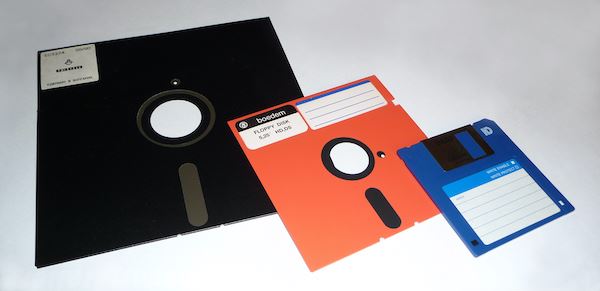Still another company has left the microfilm business: Kodak filed for bankruptcy protection some time ago. As part of the plan to save the company, Kodak management has announced the company will no longer manufacture cameras. Actually, Kodak previously had stopped the manufacture of film and cameras that use film. In recent years, Kodak has only manufactured digital cameras, and those, too, are now being dropped. The company is dropping all film products, including microfilm. The changes will have a major impact on genealogists.
For years, genealogists, historians, and many others have relied on records recorded on microfilm. Some years ago, as the volume of paper created by government and industry became too great to store economically, government and industry welcomed microfilm, microfiche, and other micro-imaging techniques. Indeed, these tiny images have served us well. Millions of cubic feet of paper records have been compressed by microfilming and have been stored in much smaller filing cabinets.
 If microfilm had never been invented, the Social Security Administration alone would have needed to build dozens of warehouses for records storage and also would have needed to hire an army of clerks to sort, file, and retrieve those pieces of paper. The cost of all that would have been in the hundreds of millions of dollars. The conversion to microfilm and microfiche literally made record storage possible.
If microfilm had never been invented, the Social Security Administration alone would have needed to build dozens of warehouses for records storage and also would have needed to hire an army of clerks to sort, file, and retrieve those pieces of paper. The cost of all that would have been in the hundreds of millions of dollars. The conversion to microfilm and microfiche literally made record storage possible.
 Now we are seeing another conversion: from micro-imaging to even smaller digital imaging. Indeed, storing millions of documents on computer disks requires even less space than does microfilm. Fewer records storage warehouses need to be built and fewer clerks need to be hired. Digital records, even with multiple off-site backups, require significantly less space than do microfilmed records and a LOT less space than the same records stored on paper.
Now we are seeing another conversion: from micro-imaging to even smaller digital imaging. Indeed, storing millions of documents on computer disks requires even less space than does microfilm. Fewer records storage warehouses need to be built and fewer clerks need to be hired. Digital records, even with multiple off-site backups, require significantly less space than do microfilmed records and a LOT less space than the same records stored on paper.
Of course, digital imaging has other benefits as well. If properly scanned and stored, high resolution digital images can be sharper and easier to read than those stored on microfilm. Digital images can have less "fuzziness." In addition, distribution and display is much easier with digital images than images on microfilm. Microfilm readers are rare in homes and in many offices while low-cost computers are available most everywhere, even in a purse or briefcase. When was the last time you carried a microfilm reader in your purse or briefcase?
 For years, one of the big arguments against digital imaging was that of the storage media. The argument has been phrased, "Who will be able to read floppies in 8-inch, 5 1/4-inch or 3 1/2-inch formats twenty or fifty years from now?"
For years, one of the big arguments against digital imaging was that of the storage media. The argument has been phrased, "Who will be able to read floppies in 8-inch, 5 1/4-inch or 3 1/2-inch formats twenty or fifty years from now?"
Now we are seeing the same argument being used against the use of microfilm: who is going to be able to read microfilm or microfiche twenty or fifty years from now? That will be long after the last microfilm viewer has been relegated to a museum.
To be sure, a microfilm or microfiche image can be viewed by using a strong magnifying glass and a bright light source. However, I have to ask: "Have you tried that?" It will work for one or two images, but I don't know of any genealogist who will sit and view hundreds of images on a single reel of microfilm by using a magnifying glass. Possible or not, viewing microfilms with a magnifying glass isn't practical for more than a few minutes.
At Archives II in College Park, Maryland, the National Archives and Records Administration maintains a museum in the Department of Special Media Preservation. Here you’ll find a recording device that uses coils of thin steel wire instead of tape. There are 70,000 18-inch glass discs, each with two hours of enemy radio broadcasts from World War II. They play on a Memovox. There are 1800 reels of push-pull movie sound-tracks using equipment that has been obsolete for more than fifty years. There are a quarter million optical discs—the cutting-edge technology of the 1980s—that depend on software and hardware no longer on the market. All of these technologies are less than a century old, and yet the materials may be gone.
 The clay tablets from ancient Sumeria can still be seen today, but one has to wonder what percentage of the media survived. Perhaps millions of such clay tablets were created. We can never be sure. All we have today is a few dozen examples.
The clay tablets from ancient Sumeria can still be seen today, but one has to wonder what percentage of the media survived. Perhaps millions of such clay tablets were created. We can never be sure. All we have today is a few dozen examples.
Medieval manuscripts on animal parchment are perfectly readable (if you can red the handwriting), and paper correspondence from the Renaissance is still in good condition. Of course, we can assume that many of the originals were destroyed by fire, floods, earthquakes, wars, insects, and human indifference. How many of the originals still survive? Again, we will never know, but we can guess. I'd suggest that the majority of medieval parchment documents did not last until the twenty-first century. I'd guess that only a tiny percentage survived.
We can go on and on. What is the shelf-life of an 8-track tape? How about the formats used? Do you remember WordPerfect? FoxPro? Netscape Navigator? Where have you gone, MS-DOS? CP/M? TRS-DOS?
Alexander Stille points out in his book The Future of the Past, "Books printed on modern acidic paper are turning to dust. Black-and-white photographs may last a couple of centuries, while most color photographs become unstable within thirty or forty years. Videotapes deteriorate much more quickly than does traditional movie film. And the latest generation of digital storage tape is considered to be safe for about ten years, after which it should be copied to avoid loss of data."
Eureka! Alexander Stille has found the answer.
Let's examine the last part of that last sentence: "...AFTER WHICH IT SHOULD BE COPIED TO AVOID LOSS OF DATA."
For centuries, the only effective method of preserving data has been to copy it to new media (disk, tape, paper, parchment, or whatever is available) while the original was still readable. Indeed, the more important documents have been copied often. Items copied frequently include the Bible, the Magna Carta, and similar documents. We all enjoy such documents today not because the originals are preserved, but because they were copied time and time again.
I will suggest that the secret of "preservation" is not to preserve, but to copy frequently. We might also want to keep the originals, but keeping readable copies becomes even more practical. Always copy to the latest storage methods in common use today. Also, we want to copy images of the originals, not create transcriptions.
Of course, there will always be a few exceptions. When looking at a Rembrandt painting, we want to view the original, not a modern-day reproduction. However, I will suggest for most all birth, marriage, and death records and other records of a similar nature, a high quality image of the original will suffice. In fact, today's digital technology can produce much higher-quality images than old-fashioned microfilm.
Who cares if a record was copied to 5 1/4-inch disk some years ago? The important thing is to have that record later copied to 3 1/2-inch disk, later still to CD-ROM, and later still to whatever new technology becomes available at the time.
The same is true for file formats. That old image may have been stored in BMP format, a file format that has almost disappeared today. Again, that is no problem if, and only if, someone copies it to .JPG or .TIFF or whatever-is-popular-today.
The big question in my mind is this: who will become the caretakers of our information? In past years, we called them "preservationists." Now, as the technology improves, we will perhaps call them "information caretakers."
Indeed, we already have thousands of "information caretakers." They already work at the National Archives, at museums, at MyHeritage.com, at Ancestry.com, at FamilySearch.org, at many libraries, and even at some of the larger genealogy societies. We already have thousands of "information caretakers" who are presently creating digital images of important records. They also are making the off-site backups, and they are converting older digital images to even more modern media as the technology improves. As the cost of storage continues to drop, we will see even more commercial companies compete with MyHeritage.com, Ancestry.com, FamilySearch.org, Google, and others to provide information to us, whenever and wherever we want it.
Some of these new "information caretaker" companies will charge fees. Others will do so free of charge although they will have to find some method of gaining revenue so that they can continue to pay their bills and stay online to provide the service. In all cases, the bottom-line costs will be lower than doing the same with microfilm.
I suspect we will not wonder for long "who will be the information caretakers?" We already have thousands of them, and even more are getting into the business daily.